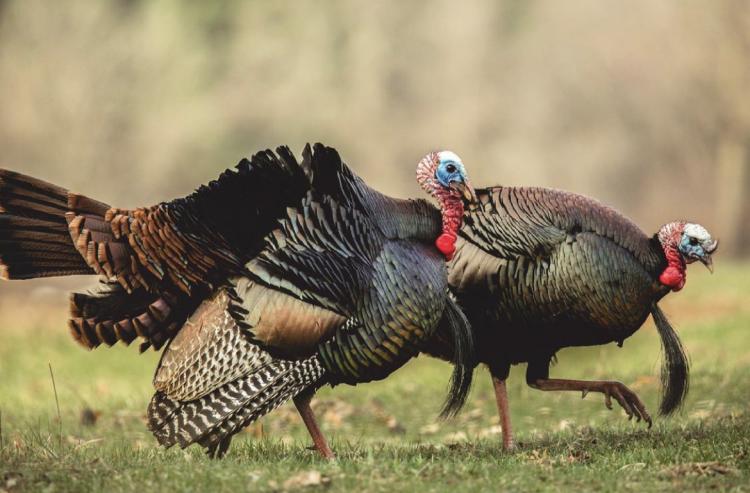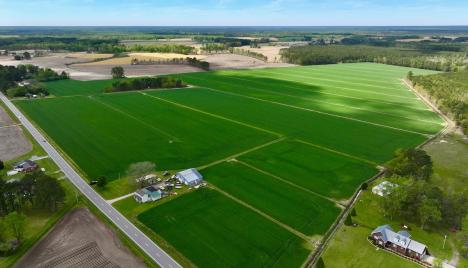Eastern wild turkeys (Meleagris gallopavo silvestris) are the most abundant and widespread of the four subspecies commonly occurring in the U.S. Their range covers most of the eastern half of the U.S. from Maine south to Florida, west to Minnesota and south across the eastern fringe of the Plains States to eastern Oklahoma and Texas; and in western Washington.
EASTERN WILD TURKEY DESCRIPTION
Wild turkeys are the largest members of the order Galliformes - chicken-like birds - with males ranging between 11-24 pounds and 39-49 inches in length, and females around 5-12 pounds and 30-37 inches. Plumage is generally dark brown with lighter, banded primary wing feathers.
The contour, or body feathers of males are black-tipped, giving the birds an overall blackish color from a distance. Up close, they show iridescent copper, bronze, red, green, and gold hues. Female body feathers are buff-tipped, making them appear more brownish in the distance, and hues are muted.
In poor light, the naked, nearly featherless heads of both sexes look similar. The female’s head is bluish-gray in color and has more feathering on the nape. During most of the year, the males head shows more pale blue and red. During the breeding season, it takes on brilliant red, white and blue shades, particularly when the bird is displaying. The front of a male’s head is adorned with a slender, fleshy appendage at the base of the bill. Called a snood, it becomes elongated and dangles beside the head when the bird is excited. Males also have larger fleshy nodes or caruncles at the base of their neck.
Males have two other physical characteristics that can be used to distinguish them from hens (sometimes). Most sport a beard - an appendage of modified feathers that dangles from the breast. Beards grow roughly three to five inches a year. A one-year-old male sporting a beard of this length is called a jake. The beard of a two-year-old male is typically 8 to 10 inches, and from this point on, he is called a tom. Males also sport spurs on back of their lower legs, which become longer, more curved and sharper at the tip with age.
EASTERN WILD TURKEY FOOD HABITS
Food habits vary with location and habitat type. Plant material, including herbaceous vegetation and hard and soft mast, makes up as much as 85 percent of an adult turkey’s diet. Young poults rely much more heavily on a protein-rich diet of insects to power their rapidly growing bodies. As they mature, their diet gradually shifts from insects to succulent plants. In late summer the diets of both young and mature birds shifts from succulent greens to hard and soft mast: seeds, nuts and berries.
EASTERN WILD TURKEY BREEDING HABITS
Turkeys are polygamous, which means one tom mates with several hens. Much like a bull elk, a tom tries to gather and defend a harem of hens. The mating process is a long, drawn-out and complex affair, the details of which influence much of how we go about hunting these magnificent birds. In simplified terms, the male gobbles, struts and drums while displaying for his hens. Once a hen finally capitulates, breeding takes place, then the tom moves on to another potential mate.
After mating, the hen gradually becomes more solitary, eventually leaving the flock to lay a single egg. She then covers the egg with leaves and duff and returns to the flock or moves off on her own to feed. She’ll also roost with the rest of the flock in trees at night. The process is repeated as she lays roughly one egg a day, sitting for about an hour after laying each of their first five eggs. Afterwards, incubation time gradually increases with the laying of each subsequent egg. Once her clutch of 10-12 eggs is complete, she will incubate continuously, day and night, leaving the nest only for brief feeding recesses.
OTHER FEATURES OF EASTERN WILD TURKEYS
While their sense of smell is rather poor, turkeys more than make up for it with their keen eyesight and hearing. The turkey’s eyesight is legendary, to which any veteran turkey hunter can attest. Rather than magnification, it is the rate at which they can assimilate detail, and their wide field of vision, which account for this. With eyes located on both sides of its head, a turkey can see in opposite directions simultaneously, and cover a field of view encompassing 300 degrees. Though they lack our telescopic vision, they can determine relative distances with a slight turn of the head, which also allows a 360-degree field of vision.
Their hearing is acute, as well. Studies suggest that they can hear in the subsonic and supersonic range, below and above the range humans hear. They also seem to be able to pinpoint the location of certain sounds. For instance, once you’ve yelped on a box call, that nearby gobbler seems to know precisely where you are; and if he’s so inclined, he can come to your exact location.
Written by Bob Humphrey






